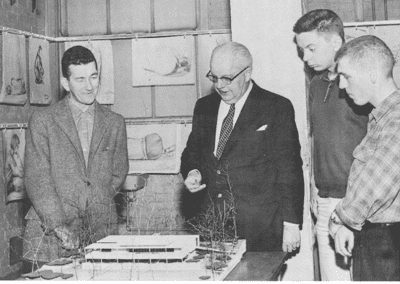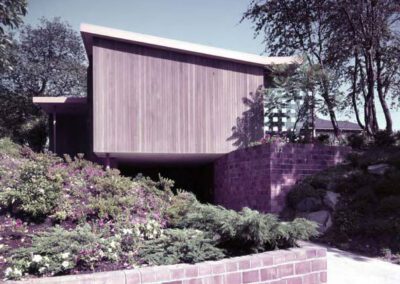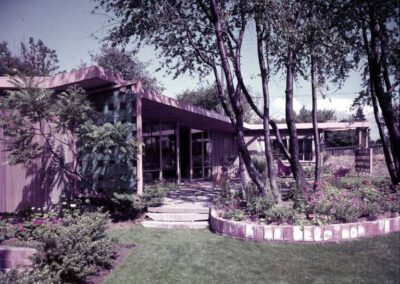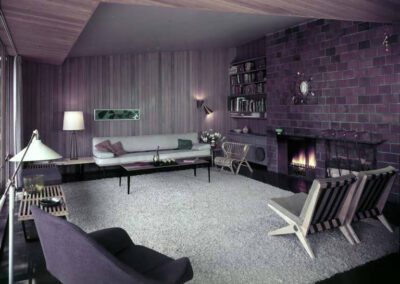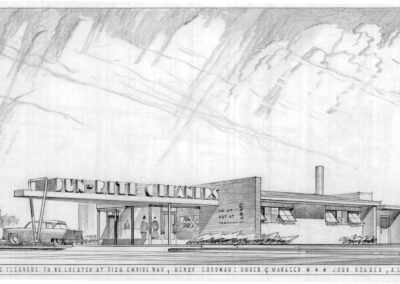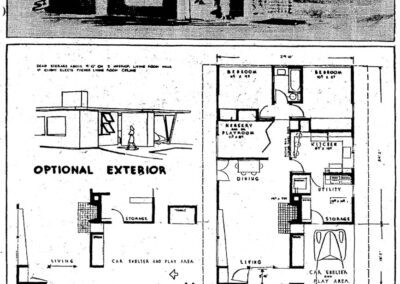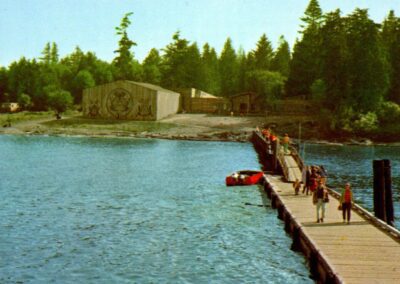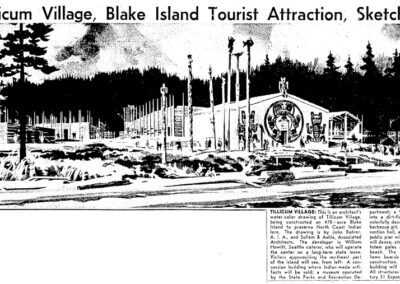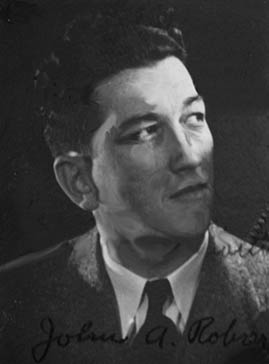
Rohrer, John A.
(1914 – 2004)
John Abram Rohrer was born in Seattle on June 18, 1914, and graduated from Queen Anne High School at the age of fifteen. Before attending the University of Washington, he spent two years working as a page at the Seattle Public Library where he fostered a love of books and reading. While there he developed a deep interest in North Coast Indian art and culture, a pastime that would greatly influence his architectural designs later in life.
Rohrer entered the architecture program at the University of Washington in 1932, where he excelled as a designer and artist. After graduation he apprenticed with architect John T. Jacobsen (1938) and then briefly with architect B. Marcus Priteca. He quickly became recognized for his skill as a delineator, and over the next several years worked for eighteen different architectural firms doing design and illustration, mostly renderings. There is some evidence that he provided many of the illustrations for the Century 21 Exposition in Seattle.
During World War II, Rohrer was employed by the Austin Company working on defense projects (1940-1945). After the war, he established his own practice and initially shared offices with Paul Kirk, James Chiarelli, and Victor Steinbrueck. The four sometimes collaborated on larger projects.
In 1948, Rohrer joined the faculty of the University of Washington’s Department of Architecture as a part-time instructor, continuing a distinguished 36-year teaching career. At the time, he was a member of the younger generation who joined the architecture faculty as the school expanded in response to the influx of returning G.I.s. That year, he collaborated with George Tsutakawa, Wendell Lovett, Robert Hugus, Ron Wilson, and William Wherette in the formation a “Basic Design” course, which was modeled after a similar program that originated at the Bauhaus and developed at Harvard’s Graduate School of Design run by Walter Gropius. The class taught basic ideas of abstract two and three-dimensional composition that were considered the fundamental beginnings to an education in modern architecture and design.
As was typical for UW faculty during the period, Rohrer continued to practice architecture on the side, providing design services on a freelance basis. Notable projects include the Timken Roller Bearing Company warehouse in the South Lake Union neighborhood (1949). Although he was often initially hired for his rendering and delineation skills, he frequently offered design suggestions; that more often than not, were accepted by the architects for whom he worked.
It was during this early period when he designed his own residence in Seattle’s Denny-Blaine neighborhood in 1952. In 1955, Rohrer became a designer and illustrator for the architectural firm of NBBJ before re-establishing his own independent practice around 1961.
Among his more notable later projects was a design for caterer William Hewitt in 1961. Hewitt had commissioned Rohrer to design a large cedar longhouse which would hold a restaurant, a performance area for Northwest Indian dancing, and a gift shop at his new Tillicum Village on Blake Island.
Rohrer retired from teaching and active practice in 1984, but continued his diverse interests in music, classical guitar, and watercolor painting. He passed away in Seattle on July 4, 2004.
– Michael C Houser
Professor Rohrer & Architecture Dean Herman Reviewing Student Project | Seattle
Source: University of Washington Yearbook – Tyee 1960
John & Ruth Roher Residence | Seattle
Built 1952 | Source: University of Washington Special Collections
John & Ruth Rohrer Residence | Seattle
Built 1952 | Source: University of Washington Special Collections
Living Room of John & Ruth Rohrer Residence | Seattle
Built 1952 | Source: University of Washington Special Collections
